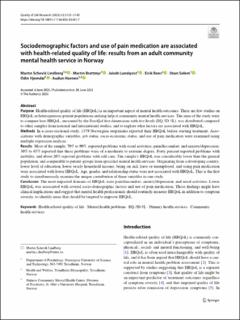| dc.description.abstract | Purpose
Health-related quality of life (HRQoL) is an important aspect of mental health outcomes. There are few studies on HRQoL in heterogeneous patient populations seeking help at community mental health services. The aims of the study were to compare how HRQoL, measured by the EuroQol five dimensions with five levels (EQ-5D-5L), was distributed compared to other samples from national and international studies, and to explore what factors are associated with HRQoL.
Methods
In a cross-sectional study, 1379 Norwegian outpatients reported their HRQoL before starting treatment. Associations with demographic variables, job status, socio-economic status, and use of pain medication were examined using multiple regression analysis.
Results
Most of the sample, 70% to 90%, reported problems with usual activities, pain/discomfort, and anxiety/depression; 30% to 65% reported that these problems were of a moderate to extreme degree. Forty percent reported problems with mobility, and about 20% reported problems with self-care. The sample’s HRQoL was considerably lower than the general population, and comparable to patient-groups from specialist mental health services. Originating from a developing country, lower level of education, lower yearly household income, being on sick leave or unemployed, and using pain medication were associated with lower HRQoL. Age, gender, and relationship status were not associated with HRQoL. This is the first study to simultaneously examine the unique contribution of these variables in one study.
Conclusion
The most impacted domains of HRQoL were pain/discomfort, anxiety/depression, and usual activities. Lower HRQoL was associated with several socio-demographic factors and use of pain medication. These findings might have clinical implications and suggest that mental health professionals should routinely measure HRQoL in addition to symptom severity, to identify areas that should be targeted to improve HRQoL. | en_US |

